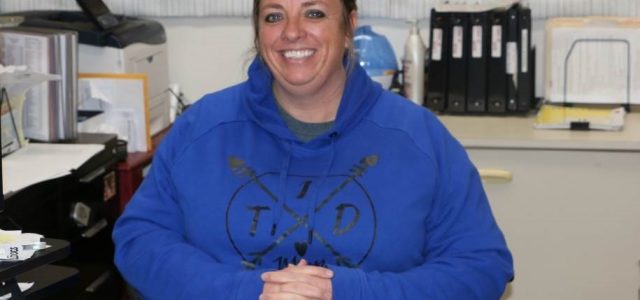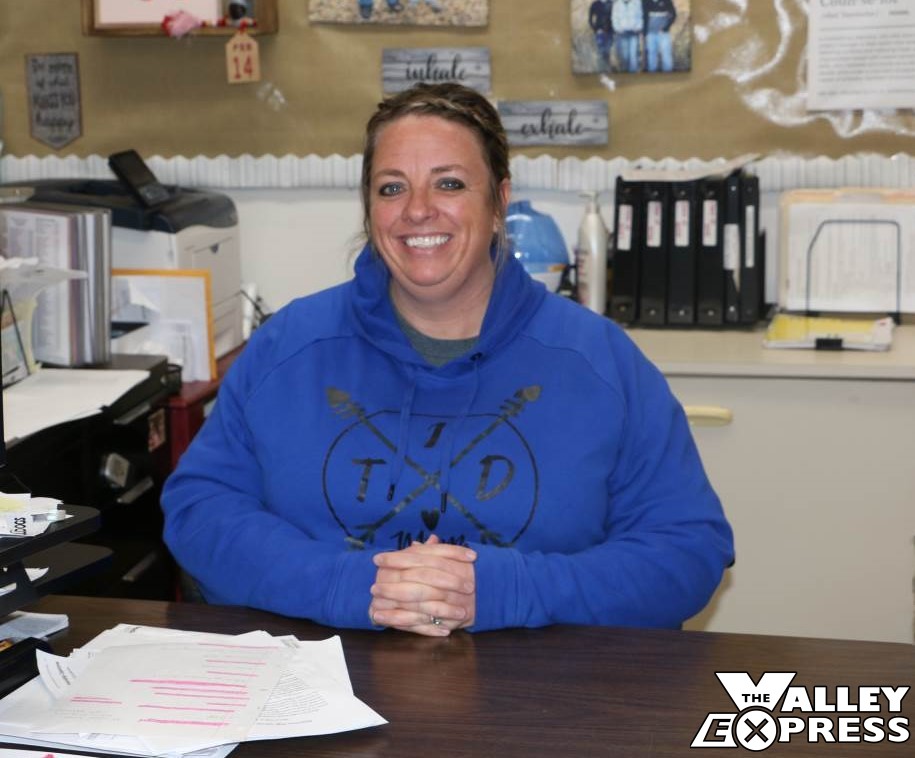

Have you ever counted how many choices you make in a day? There isn’t an app on your phone to keep track of that, but researchers estimate the average person makes around 122 informed choices each day. If you count the teensy-weensy decisions –including all the subconscious ones – that number climbs to an eye-popping 35,000.
Heidi Wellnitz has served as the school counselor in the Milbank School District for the past 17 years. Her job is to help kids navigate a sea of choices. What classes should I take? Which college is best for me? Should I listen to my friend’s advice? She doesn’t tell kids what to do, she just points them in the right direction. Easy, right? Sure. Most of the time it’s like riding a bike. Just assume the bike is on fire. You’re on fire. Everything is on fire.
Not every day is fraught with disaster or teenage angst, but she says, “It’s always something different, and that’s my favorite part. Also, when a student comes into my office, and their problem ends with a smile, or I see something click and they finally start to understand that things are going to be okay, that makes it all worthwhile.”
During National School Counselor Week, February 5-9, schools across the country are honoring school counselors for the important role they play in helping students to develop academic and social skills, assist in crisis management, and facilitate better mental health. Another major responsibility school counselors undertake is to help students choose a path to employment. It might be crazy to expect a high schooler to select a career before he or she is even able to vote, book a hotel room, or rent a car, but that’s reality.
Heidi says, “I tell kids that I graduated from college and didn’t know what I wanted to do. It’s okay to change your mind even though you think you know now.” She says she sees a lot of students who intend to be doctors. “I just say,’ That’s fine. Everyone needs goals, but it’s okay after you get to college to pick something different.’”
In the early years of her own career, Wellnitz took a sharp turn. “I attended SDSU. I thought I wanted to be a preschool teacher, but I found out really quickly that I didn’t.
An internship was part of her human development and family studies degree program, and she says, “A lot of people did their internships right in Brookings. I wanted to go somewhere else and do something different. So I moved to Minneapolis. My mom (Susan Jacobs-Moen) lived in Chanhassen and I got an internship at the Bridge for Runaway Youth in Minneapolis. I worked with homeless kids or kids that had run away from home.”
The Bridge for Youth was founded in 1970 by Sister Rita Steinhagen and Sister Marlene Barghini of The Sisters of St. Joseph of Carondelet. The pair had noticed a growing number of youth on the streets of Minneapolis. The Bridge at Riverside became one of the nation’s first safe havens for youth experiencing homelessness. In 1997, The Bridge also began one of the first transitional living programs in the U.S. for youth ages 16-20. A bridge was used as a metaphor for eventually reuniting the child and their family.
Heidi says her internship morphed into a job. “I worked there that whole summer. I realized I liked the counseling aspect of it, and I started thinking maybe that was what I wanted to do. I decided to go to Northern to get my masters in counseling.” She was at the point when a grad student was required to select mental health counseling or school counseling. “I chose school counseling because I wanted to make sure I could see both sides,” Heidi says, “In schools, you also get the career aspect. Every day is something different. She was hired for her first position as a school counselor for the Mobridge School District, where she worked for two years.
Now, nearly 20 years later, in Milbank, Heidi sees some problems that weren’t an issue in the early 2000s. Social media is the biggest one, but it’s an obvious problem as opposed to vaping. “Nationwide, we’re seeing that vaping is a huge problem, and it’s so new,” she says. It’s something kids can easily do. You can do it in your bedroom. You can do it in your car. You can do it just about anywhere. The products are very accessible and very easy to hide. It’s pretty addictive. It’s also hard to know all the side effects.” She notes really young children are becoming hooked. ”Depending on their surroundings and if mom and dad are doing it, sometimes kids get started even before they get to middle school.”
She also believes that people might not understand how big the mental health issue really is in school and in our community. What she hopes will happen, and what she has been working towards, is removing any stigma attached to mental health. She tries to drive home several points: “It’s okay to ask for help. It’s okay if something’s hurting on the inside, and no one can see it.” She says she explains to the kids that physical health problems are so acceptable, but mental health problems aren’t given the same latitude. “If you suffer from a broken arm, everyone can see you have a broken arm. It’s usually impossible to see something on the inside.” She tells them,” It’s okay to come in if you’ve had a rough night at home or you just want to talk. Sometimes we need help to get us on the right path and that’s okay. If you have heart disease, you might require heart medication. If you’re diabetic, you need insulin. Mental health is no different.” She pauses and then adds, “I think we’re getting there.”
She says, “Most kids worry about what I would call the unknowns. That’s probably been consistent through the years. They think they know what they want, but then they start to wonder, ‘Is it going to be what I think it is? Leaving home… What does that feel like? There are just a lot of unknowns out there.”
She believes the number one thing parents can do is to talk to their kids. “If you notice big changes, they go in their room all the time, different things like that, just try to talk to them. I think it’s easy for a parent to dismiss it by saying ‘They’re in high school, it’s typical of that age to just sit in their room.’ I hope parents don’t let this get by them. Have those conversations and make them part of your day.”
“It’s hard to determine if mental health issues are more prevalent today than in the past,” she says. “Maybe it just seems like a lot more because we’re talking about it more. We’re probably asking for help more, too. Social media use has increased and kids don’t ever get a break from it. Before they could go home and it was just home.”
“And because my generation didn’t use social media growing up, we have to learn how to parent around it, and it’s hard because kids want it (social media) all the time. And we know that kids shouldn’t have it all the time. Kids are better with guidelines. But, I guess we’re all learning together on that one.”
For the most part, Heidi believes Milbank is blessed with super supportive parents. “Maybe some don’t back us as much as we’d like. Obviously, that Mama bear can come out in anyone. But I feel that 99 percent of the time when I pick up the phone or have a meeting with parents, we usually come to an agreement and leave knowing that we both want what’s best for the child. We’re actually after the same goal. How can we get there? Through communication usually.”
Teachers make a difference, too. ”Not a day goes by that a teacher doesn’t come in here asking ‘Can you give me some insight on this student? Is something going on? Do they deserve a little more grace today? Or ‘how would you respond to this?’” We all want these kids to succeed. That’s why we’re here.”
“Our community is also great and some people are constantly giving to the kids. I feel like they allow me to be the giver. I maintain a closet in the back for when kids need clothes. I know not every school counselor has this option, but I do, and it’s so great.
I bet I have given out 25 coats this season. Socks, underwear, things like that. Just this morning, someone needed a pair of pants”. We have things like hygiene products, too. It’s like a little store back there.” She says the teachers are very good at putting a bug in her ear about a student in need.
The need, of course, spills over into food. Teenagers are always hungry. Some more than others. The Backpack program provided by the GCCSC offers assistance, but Heidi points to a bin and says.” I have a tote right here full of granola bars. Another family and I kinda just keep it full. Teachers, staff, and the community – everyone is working together to help the kids get what they need.”
It’s probably a combination of making sure our kids are okay now and that they will be ready when it’s time to leave. We have them for such a short time and we get to see such a small piece of them. I’ve seen kids who have very good GPAs, but they do not do as well away at school. But they go full circle and come back here, find a different career, and are super successful. I also see kids who work their tails off in school, and people say, ‘Oh, they’re never gonna make it.’ But, they do! They have a strong work ethic and goals, and they get to where they want to be. We can never assume or count out any kids. They grow up and change – what wasn’t a priority back then, sure is now.”
“Every fall, we go to Lake Area and SDSU so the students get a chance to see a technical college and a college. Then, when they do their college visits, they have something to compare. The kids who are already at SDSU know when we are coming, and it’s like a big reunion. They all try to find us at that ice cream bar or when we’re having our meeting. It’s fun.”
A lot of kids aren’t convinced college is the path they want, though, and I tell them ‘if you know what you want to do, by all means, go do that right away. Don’t rack up a huge amount of debt at a four-year college first. There are some great technical colleges and technical degrees out there… search tech, robotics, whatever you want. There’s a misconception that you have to have a four-year degree to make money.
Pay is very important to a lot of the kids. Some also think ‘I don’t want to be stuck inside. I really like the outdoors.’ Some know that they don’t want to be in a small town. Pay is on a lot of the kids’ minds, though. Sometimes we have to talk about that, “Okay, higher pay might come with not being at home quite as much or maybe with a lot more travel. If you want to be family-oriented, it’s something to consider. Technology really comes in handy in these situations. The students can look up interest-inventories that describe different careers and talk about what the day-to-day experience is for that job. They can also find interviews with people in those positions. A lot of resources are available at their fingertips, and they research things a lot earlier now.”
Heidi still remembers the name of her high school counselor (shout out to Barbara who was the counselor then at Webster High.) and she thinks the difference between their two jobs is like night and day. “A lot has changed even with my job over the 19 years. Technology alone is such a huge change. I remember I used to have a board that I’d pin the scholarships on to deliver them to the kids. Now, it’s email.”
One part of her job that she absolutely loves is doing the 10-year recap of the Milbank Foundation winners. “I am always in awe. Wow! These kids all came from Milbank and look at the big things they’re doing. We have kids making or doing things that are affecting, not only Milbank, but also South Dakota, and the whole United States. Others are doing research in different countries. It’s just amazing the things our kids have accomplished!” They all started by making decisions. Big decisions. Little decisions. Maybe it’s just 122 of them each day, but they all add up.
Heidi also advises the students to choose good people. She says,“With good people around you, you will find you are making good decisions and doing the right thing. Life will be easier.”
Maybe you graduate this year or maybe you left the nest 10, 20, 30 years ago or more. Remember, it’s never too late to change your mind or change your course and do as the author Edmund Lee suggests, “Surround yourself with the dreamers and the doers, the believers and the thinkers. But most of all, surround yourself with those who see the greatness in you – even when you can’t see it yourself.”













No comments so far.
Be first to leave comment below.